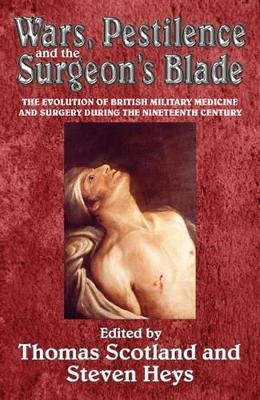
Wars, Pestilence and the Surgeon's Blade
Helion & Company (Verlag)
978-1-909384-09-5 (ISBN)
This book examines the development and evolution of surgical practice against this overwhelming risk of death due to disease. It reviews three major conflicts during this time: the Peninsular War, the Crimean War and the Boer War and also considers many minor wars fought by the British Empire in the intervening years, and highlights significant medical and surgical developments during these conflicts.
War surgery in the first part of the 19th Century was brutal and it had to be carried out swiftly. It was performed at speed because there were no anaesthetics and the wounded often died during the procedure. Surgeons focussed their attention on wounds of the arms and legs, because limbs were both easily accessible to the surgeon (unlike organs inside the abdomen and chest) and lent themselves well to amputation. This was commonly the operation of choice for many war wounds of arms and legs. Some surgeons performed more difficult surgical procedures to try to preserve the limbs and attempted to repair damaged tissues but these operations took longer and caused greater suffering to the patient. Abdominal and chest wounds were not treated since surgeons did not have the means, the ability, or the understanding, to cut into the abdomen and chest to repair the damaged organs successfully.
An important development which contributed to surgery moving forwards was the discovery of general anaesthesia, which became available in time for the Crimean War. However, whilst it certainly rendered operations pain-free, it was associated with significant numbers of deaths during surgery on wounded soldiers because of the poorly understood effects that anaesthetics had, particularly on the heart. As a result, operative surgery did not extend its scope a great deal, and military surgery remained focussed on surgery of the limbs. However, fewer amputations were performed during the Boer War at the end of this period.
Tom Scotland - Born in St. Andrews and brought up in the East Neuk of Fife, Tom was educated at Waid Academy in Anstruther. He graduated in Medicine from the University of Edinburgh 1971, becoming a fellow of the Royal College of Surgeons of Edinburgh in 1975. He developed his interest in the Great War whilst a student, when there were still many veterans alive. He trained in orthopaedic surgery in Aberdeen, and after spending a year as a fellow in the University of Toronto, returned to take up the position of Consultant Orthopaedic Surgeon with Grampian Health Board and Honorary Senior Lecturer at the University of Aberdeen. His particular interests were knee surgery, paediatric orthopaedics and tumour surgery, and for three years was lead clinician for the Scottish Sarcoma Managed Clinical network. Over the years he has been a frequent visitor to the Western Front, and has found cycling the best way to visit different places. He has explored many areas of the Western Front with family and friends and since retiring from the National Health Service in 2007 has kept in touch with former colleagues by leading cycling expeditions to the Western Front. He has pursued his interest in the Great War by making a particular study of Aberdeen surgeon, Sir Henry Gray, who played a pivotal role in the development of surgery on the Western Front, and has given various lectures on the development of surgical services during the Great War. In retirement he has completely re-invented himself as a cycling orthopaedic historian. Steve graduated in Medicine from the University of Aberdeen and is a Fellow of the Royal Colleges of Surgeons in England, Edinburgh and Glasgow and currently Dean of the School of Medicine, Medical Sciences and Nutrition at the University of Aberdeen. His surgical specialty is breast cancer surgery and he has research interests in the role of nutrition in the causation of cancer, and has responsibilities for medical education both locally and nationally. He has published more than 200 scientific papers and written many book chapters on different aspects of surgery and played many national and international roles in surgery and the provision of surgical services. His interest in the Great War was sparked by the stories of the Accrington pals and the Lancashire Fusiliers, by his time as a member of the RAMC (V), serving for six years in the 51st Highland Brigade, and by Tom's famous cycling tours around the Western Front where he has the dual role of bicycle mechanic, and because he is a keen bagpipe player, has been appointed as Piper to the tours! He is co-author of three books "War Surgery 1914-1918", "Wars, Pestilence and the Surgeon`s Blade" and "Understanding the Somme 1916-An Illuminating Battlefield Guide."
| Reihe/Serie | Helion Studies in Military History |
|---|---|
| Zusatzinfo | 75 b/w ills, figs, maps, 37 tables |
| Verlagsort | Solihull |
| Sprache | englisch |
| Maße | 156 x 234 mm |
| Themenwelt | Geschichte ► Allgemeine Geschichte ► Neuzeit (bis 1918) |
| Geschichte ► Teilgebiete der Geschichte ► Militärgeschichte | |
| Medizin / Pharmazie ► Medizinische Fachgebiete ► Arbeits- / Sozial- / Umweltmedizin | |
| Medizin / Pharmazie ► Medizinische Fachgebiete ► Chirurgie | |
| Studium ► Querschnittsbereiche ► Geschichte / Ethik der Medizin | |
| Studium ► Querschnittsbereiche ► Klinische Umweltmedizin | |
| ISBN-10 | 1-909384-09-7 / 1909384097 |
| ISBN-13 | 978-1-909384-09-5 / 9781909384095 |
| Zustand | Neuware |
| Haben Sie eine Frage zum Produkt? |
aus dem Bereich


